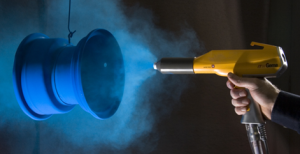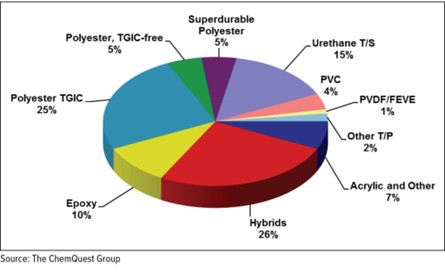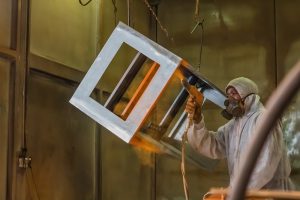
Introduction
Powder coatings are solvent-free finishes used in a wide range of industries for protecting and enhancing the appearance of metal and other surfaces. Unlike traditional liquid paints, powder coatings are applied in a dry form and cured to create a durable, high-quality finish. The use of powder coatings has grown significantly due to their environmental benefits, cost-effectiveness, and superior performance in comparison to solvent-based coatings.
Applications of Powder Coatings
Powder coatings find widespread use in various industries, including:
– Automotive: Used for coating wheels, trims, chassis, and other components requiring high durability and corrosion resistance.
– Appliances: Applied to refrigerators, washing machines, ovens, and other appliances to provide a tough, protective, and aesthetically appealing finish.
– Architectural and Construction: Used for both indoor and outdoor aluminum and steel structures such as window frames, doors, fences, and facades.
– Furniture: Metal office furniture, shelving, and outdoor furniture are powder-coated for increased lifespan, color retention, and scratch resistance[1].
– Electronics: Powder coatings are used to protect electrical components such as junction boxes and heat-sensitive electronics due to their excellent thermal and electrical insulation properties.

Overview of Raw Materials and Their Functions
Powder coating formulations consist of several key raw materials, each with a specific role in achieving the desired coating properties:
- Resins/Binders
Resins form the backbone of the coating and provide essential mechanical properties such as adhesion, chemical resistance, and hardness. Typically, thermoset and thermoplastic resins are used in powder coatings.
– Thermoset resins (epoxy, polyester, polyurethane, acrylic) crosslink when cured, providing a hard, permanent finish.
– Thermoplastic resins (polyethylene, polyvinyl chloride) can be re-melted after curing but are less commonly used.

– Used primarily in thermosetting formulations, curing agents (e.g., dicyandiamide for epoxies, isocyanates for polyurethanes) react with the resin to form a crosslinked network during the curing process. The curing agent type impacts the final coating’s flexibility, chemical resistance, and hardness.
- Filers
Fillers reduce the formulation cost and modify the mechanical properties, such as increasing stiffness, improving flow, or providing better impact resistance.
Examples of fillers used are: Calcium carbonate, barium sulfate, talc.
- Additives
– Additives improve specific characteristics of powder coatings. Examples include:
– Flow modifiers (e.g., acrylics) for smoother finishes.
– Degassing agents to prevent bubble formation.
– UV stabilizers for enhanced outdoor performance.
– Antimicrobial agents for hygiene-sensitive applications.
Pigments provide color, opacity, and, in some cases, UV protection. Metallic or pearlescent pigments can add decorative effects.
Examples: Titanium dioxide (white), iron oxides (reds, browns), phthalocyanines (blues, greens).
– Catalysts accelerate the crosslinking process, especially in low-temperature cure applications, thus reducing energy consumption during curing. Examples include amines or imidazoles for epoxy systems.
Gain the ingredient insights you need with Prospector Premium. Learn more here!
Application Methods and Curing Conditions
- Application methods
The most common methods for applying powder coatings are:
– Electrostatic Spray Deposition (ESD):
– In this method, the powder particles are electrostatically charged and sprayed onto a grounded substrate. The charged particles adhere to the surface, forming an even coating.
– Fluidized Bed Coating:
– Pre-heated substrates are dipped into a fluidized bed of powder, where the powder particles melt and adhere to the surface. This method is typically used for thicker coatings or complex geometries.
– Tribostatic Spraying:
– This method is similar to ESD but uses friction to charge the powder instead of an electrical field. It is used for applications where ESD is challenging, such as on intricate surfaces or non-conductive substrates.
- Curing Conditions
Curing is a critical step in the powder coating process, where the coated object is heated to initiate the crosslinking reaction in thermosetting powders.
– Typical curing temperatures are 150 °C to 200 °C (302 °F to 392 °F) for a period of 10 to 30 minutes depending on the coating formulation.
– Low-temperature curing systems: Advances in chemistry have enabled curing at lower temperatures (e.g., 120°C to 150°C), ideal for heat-sensitive substrates like plastics or composites.
The curing temperature and time directly influence the mechanical properties, chemical resistance, and adhesion of the final coating.
Here are five key tips to help ensure your success:
- Prioritize Cleanliness
Regularly clean jigs and ensure the air used during the powder spraying process is free of impurities. Consider using an air-drying refrigeration unit to help maintain clean, dry air throughout the process. - Prevent Contamination
Thoroughly clean application and recovery systems after each use. Keep different colors and powder types separate, and be aware of potential contamination from inadequate pretreatment or lubricants in mechanical conveyor tracks. - Optimize Resource Efficiency
Maximize resource efficiency by recycling overspray powder. Use a powder recovery system to collect overspray, and mix it with fresh powder for reuse. Be sure to sieve and mix the powder, following the recommended maximum reuse rate of 30%. - Perfect the Curing Process
The curing process varies based on factors like substrate type, part size, shape, and color. Larger parts require longer cure times, and it’s important to monitor cross-sections for potential temperature variations. Ensure even curing by paying attention to temperature gradients in the oven. Curing begins once the part reaches the required temperature, causing the powder to melt, flow, and form a smooth protective coating. - Store Powders Properly
Store your powders in a cool, dry environment to maintain their quality. Regularly rotate stock to keep it fresh, and avoid temperatures above 20°C, as this may shorten the powder’s shelf life.

Latest Trends in Powder Coating Technology
- Low-Temperature Curing Formulations:
– As manufacturers strive for energy efficiency, low-temperature curing systems are gaining traction. These systems reduce the energy required during the curing process and broaden the range of substrates that can be powder coated, including plastics and composites.
- Super-durable Powders:
– Modern powder formulations have improved durability and weather resistance, making them ideal for outdoor applications such as architectural finishes, where UV exposure and extreme weather can degrade coatings over time.
- Thin-film Powder Coatings:
– Thin-film powder coatings are designed to provide the same level of protection and aesthetics as conventional coatings but at significantly reduced thicknesses (30-60 µm). This leads to material savings and lower emissions.
- Anti-microbial and Anti-graffiti Coatings:
– The demand for antimicrobial coatings has surged, especially in healthcare and food-processing environments. Anti-graffiti coatings are gaining popularity in urban infrastructure to reduce the cost and effort associated with cleaning graffiti.
- Eco-Friendly Formulations:
– With growing environmental concerns, formulators are focusing on producing powders with no volatile organic compounds (VOCs), minimal hazardous air pollutants (HAPs), and sustainable raw materials, including bio-based polymers[2].
- Nanotechnology incorporation
A major breakthrough in powder coatings is the incorporation of nanotechnology. By using nanoparticles, such as silica or zinc oxide, the coating’s characteristics—like hardness, scratch resistance, and UV stability—are significantly improved. Nanotechnology also enables the creation of self-healing coatings, which can repair minor surface damage, thereby prolonging the lifespan of the coated product.
Guideline Formulation for Epoxy/Polyester Hybrid Powder Coating
A typical guideline formulation for an epoxy/polyester hybrid powder coating is outlined below:
| Component | Parts by weight |
| Epoxy resin | 30 |
| Polyester resin | 30 |
| Curing agent (e.g. TGIC) | 5 |
| Flow modifier | 1 |
| Degassing agent | 0.5 |
| Pigment (TiO2) | 10 |
| Filler (e.g. Barium Sulfate) | 20 |
| Additives (UV stabilizer, etc.) | 1-2 |
– Curing conditions: 180 °C for 15 minutes
– Coating thickness: 60-80 µm
– Application method: Electrostatic spray deposition
This formulation provides a good balance of mechanical properties, chemical resistance, and aesthetic appeal for general-purpose use in industrial applications.
More specific examples of powder coatings formulations can be found on the website of UL prospector.
Conclusion
Powder coatings continue to evolve, offering superior performance with minimal environmental impact. With advancements in low-temperature curing, thin-film applications, and eco-friendly formulations, powder coatings are positioned as a leading solution for high-performance surface finishes across various industries. Future developments are expected to push the boundaries of sustainability and functionality even further.
[1] Ayrilmis, N. (2022). A review on electrostatic powder coatings for the furniture industry. International Journal of Adhesion and Adhesives, 113, 103062.
[2] Czachor-Jadacka, D., Biller, K. & Pilch-Pitera, B. Recent development advances in bio-based powder coatings: a review. J Coat Technol Res 21, 435–444 (2024).
The views, opinions and technical analyses presented here are those of the author or advertiser, and are not necessarily those of ULProspector.com or UL Solutions. The appearance of this content in the UL Prospector Knowledge Center does not constitute an endorsement by UL Solutions or its affiliates.
All content is subject to copyright and may not be reproduced without prior authorization from UL Solutions or the content author.
The content has been made available for informational and educational purposes only. While the editors of this site may verify the accuracy of its content from time to time, we assume no responsibility for errors made by the author, editorial staff or any other contributor.
UL Solutions does not make any representations or warranties with respect to the accuracy, applicability, fitness or completeness of the content. UL Solutions does not warrant the performance, effectiveness or applicability of sites listed or linked to in any content.
